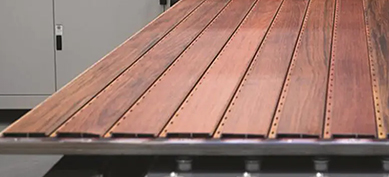The selection of fencing materials is a critical decision for contractors, landscapers, and property developers. While aesthetics, durability, and cost are paramount, the factor of installation efficiency often tips the scales. Labor is a significant portion of any project’s budget, and a system that reduces time on site without compromising quality is immensely valuable. This is where the WPC fence panel system distinguishes itself. Its design philosophy is intrinsically linked to streamlined installation, offering a compelling alternative to traditional wood or wrought iron fencing.
The Foundational Design: Modularity and Integrated Systems
At its core, the ease of installing a WPC fence panel system stems from its modular, integrated design. Unlike traditional fencing, which is often built piece-by-piece on-site, a modern WPC fence panel system arrives as a kit of pre-engineered components designed to fit together with precision. This approach transforms a custom construction project into a more straightforward assembly task.
The primary component is the WPC fence panel itself. These panels are manufactured to consistent dimensions, ensuring that every panel in an order is uniform. This uniformity eliminates the time-consuming process of measuring, cutting, and fitting individual pickets to achieve a consistent look and spacing. The panels are typically capped with robust top and bottom rails, protecting the core material and providing a solid structure for attachment. The integrated nature of the panel means that the most visually complex part of the fence—the array of pickets—is handled off-site in a controlled factory environment.
Supporting this modularity is the post-and-rail system. Hidden fastener systems are a hallmark of well-designed WPC fencing. Instead of nailing or screwing through the face of the panel, which can be visually unappealing and risk damaging the material, these systems use channels, clips, or brackets that attach to the posts. The WPC fence panel then simply slots or clips into these hidden fixings. This method not only creates a clean, seamless appearance but also drastically speeds up the process of securing each panel, as it removes the need for precise pilot drilling and careful screw placement on the visible surface. The alignment is built into the system, ensuring panels are level and plumb with minimal effort.
Component Breakdown: Engineered for Efficiency
To understand the installation advantages, one must look at the individual components and how they are engineered for efficiency.
Posts: The posts in a WPC fence panel system are more than just supports; they are the anchors of the entire structure. They are often designed as universal components, meaning a single post design can be used for end-of-run, corner, and line applications, simplifying material ordering and on-site logistics. Many systems feature pre-notched posts or integrated channels at precise intervals corresponding to the panel dimensions. This design allows installers to simply slide the panel’s rails into these pre-formed slots, guaranteeing correct height and alignment every time. Furthermore, these posts are frequently designed to be compatible with standard metal post spikes or concrete footing systems, providing flexibility in foundation choice based on soil conditions and local building codes.
Panels: As mentioned, the WPC fence panel is the star of the system. Its composite nature—typically a blend of wood plastic composite (WPC) materials—makes it significantly lighter than solid wood panels of a comparable size, yet far more robust and stable than vinyl. This reduced weight makes a single WPC fence panel manageable for one or two people to maneuver into position without requiring heavy machinery. The material’s consistency also means it will not warp, twist, or split during installation, a common frustration with natural wood that can lead to wasted time and materials. The panels are also pre-finished, eliminating the need for on-site staining, sealing, or painting.
Hardware and Fasteners: A complete system includes all necessary, often proprietary, hardware. This includes the aforementioned hidden clips, brackets, and caps. Having a single source for all fasteners ensures compatibility and removes the guesswork from selecting the correct screw type or length. Galvanized or stainless steel hardware is standard, providing corrosion resistance and long-term structural integrity without requiring additional treatment from the installer.
The following table summarizes the key component features that contribute to installation ease:
| Component | Key Feature | Installation Benefit |
|---|---|---|
| WPC Fence Panel | Uniform pre-assembled dimensions | Eliminates on-site picket spacing, measuring, and cutting. |
| WPC Fence Panel | Lightweight yet rigid material | Easy to handle and position; will not warp during installation. |
| Post | Universal design & pre-notched slots | Simplifies material inventory; ensures automatic panel alignment. |
| Fastening System | Hidden clip/channel design | Creates a clean look; speeds up attachment without visible screws. |
| Hardware Kit | Complete, corrosion-resistant included fasteners | No guesswork; ensures long-term stability and reduces return trips. |
The Streamlined Installation Process: A Step-by-Step Advantage
The practical benefits of these design and component features become most apparent during the actual installation process. A typical project follows a logical, efficient sequence.
1. Planning and Layout: The process begins with standard layout and marking of post locations. The fixed width of the WPC fence panel dictates the post spacing, which is a known value. This allows for precise calculation of material needs and accurate marking of the site before any digging begins, reducing errors and adjustments later.
2. Post Setting: Posts can be set using concrete footings for maximum permanence or, more efficiently in many cases, with drive-in metal post spikes. These spikes are driven into the ground, and the post is then secured into a bracket on the spike. This method is exceptionally fast, requires no mixing or curing time for concrete, and allows for installation to proceed immediately. The universal post design means installers are working with a single component type for most posts.
3. Panel Installation: This is the stage where the WPC fence panel system saves the most significant amount of time. Once the posts are set and aligned, installers simply lift a panel into place, slotting its rails into the pre-notched channels on the posts. With the panel held securely in position, the hidden fasteners are then engaged—often with a few screws into the post structure. This process is repeated for each subsequent panel. There is no need to hold a spirit level against every individual panel, as the post channels ensure they are hung correctly. The lack of face-nailing means there is no finishing work to cover screw heads.
4. Finishing Touches: Finally, post caps are installed. These caps, often made from a durable polymer or the same WPC material, snap or screw onto the top of each post. They serve a dual purpose: protecting the post’s inner core from water ingress and providing a polished, completed look to the fence line. The inclusion of matching gates designed with the same mounting hardware further streamlines the project, creating a cohesive and professionally installed result.
Tangible Benefits for Professional Installers
The cumulative effect of this engineered system translates into direct, tangible benefits for installation professionals.
Reduced Labor Time and Cost: This is the most significant advantage. A project that might take a crew two or three days with traditional materials can often be completed in a single day with a WPC fence panel system. This efficiency allows contractors to take on more projects within the same timeframe, increasing overall profitability and reducing labor costs on a per-project basis.
Minimized Skill and Tool Requirements: While professional results are guaranteed, the skill threshold for achieving them is lowered. The system is designed for success, reducing the need for highly specialized carpentry skills for tasks like precise picket spacing or complex angled cuts. The required tools are typically standard: a level, a mallet, a post hole digger or spike driver, and a power drill/driver. There is no need for table saws, nail guns, or painting equipment on site.
Predictability and Reduced Waste: The precision of factory manufacturing leads to extreme predictability. Contractors can be confident that every WPC fence panel will fit as intended, with no surprises. This consistency, combined with the minimal on-site cutting required, leads to a dramatic reduction in material waste. Off-cuts and mis-cut pieces are virtually eliminated, which is both economically and environmentally beneficial.
Year-Round Installation Capability: The stability of the WPC material is a key advantage. Unlike wood, which can be delivered to a site and quickly absorb moisture, swell, or warp before installation, WPC fence panels remain dimensionally stable in rain, sun, or humidity. This allows installers to confidently accept and complete projects in a wider range of weather conditions without worrying about material degradation affecting the installation process or final quality.

 English
English Español
Español



